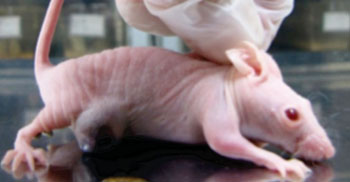Fusion Gene Promotes Growth of Malignant Cutaneous Angiosarcoma
By LabMedica International staff writers
Posted on 12 Nov 2015
A team of Japanese cancer researchers highlighted the importance of an oncogenic fusion gene to the formation and progression of the malignant skin cancer cutaneous angiosarcoma.Posted on 12 Nov 2015
Cutaneous angiosarcoma commonly occurs on the scalp of elderly people and can rapidly metastasize to the liver, lungs, or lymph nodes. Its five-year survival rate is only 20%–30%, so new diagnostic and therapeutic approaches are urgently required.

Image: The image shows tumor induced in a mouse following subcutaneous injection of cells containing the NUP160 - SLC3A3 fusion gene (Photo courtesy of Dr. Masatoshi Jinnin, Kumamoto University).
Investigators at Kumamoto University (Japan) and Kitasato University (Tokyo, Japan) used transcriptome sequencing—the analysis of the library of genes being actively read and transcribed by a cell—from patient-derived angiosarcoma cells (ISO-HAS) to search for chromosome rearrangements.
They reported in the November 1, 2015, online edition of the journal Cancer Research that they had identified a novel fusion gene NUP160–SLC43A3 that was expressed in 9 of 25 human angiosarcoma specimens that were examined. In tumors harboring the fusion gene, the duration between the onset of symptoms and the first hospital visit was significantly shorter, suggesting more rapid tumor progression.
Cancer cells expressing the fusion gene were implanted subcutaneously into immunodeficient mice. By the end of five weeks, the implants had induced formation of tumors in the mice that were similar to human angiosarcoma.
"The identification of this novel fusion gene has potential implications for new diagnostic and therapeutic approaches for this area of cancer research," said contributing author Dr. Masatoshi Jinnin, associate professor of dermatology and plastic surgery at Kumamoto University. "Furthermore, earlier hospital visits by these patients often means that the disease has not yet metastasized. Their prognosis can be improved by implementing appropriate treatments immediately after diagnosis."
Related Links:
Kumamoto University
Kitasato University













